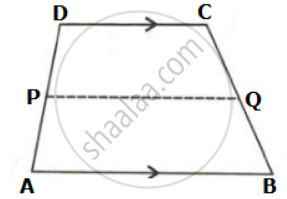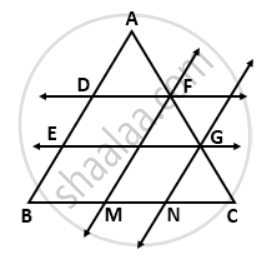Advertisements
Advertisements
Question
D, E, and F are the mid-points of the sides AB, BC, and CA respectively of ΔABC. AE meets DF at O. P and Q are the mid-points of OB and OC respectively. Prove that DPQF is a parallelogram.
Solution

Given: △ABC, D, E, F are midpoints of AB, BC, AC respectively. AB and DF meet at O. P and Q are midpoints of OB and OC respectively.
To Prove: DPFQ is a parallelogram.
Proof:
In △ABC,
D is the mid-point of AB and F is the mid-point of AC
Hence, DF ∥ BC and DF = `1/2`BC ... (1) (Mid-point theorem)
In △OBC,
P is the mid-point of OB and Q is the mid-point of OC
Hence, PQ ∥ BC and PQ = `1/2`BC ... (2) (mid-point theorem)
thus, from (1) and (2)
DF ∥ PQ and DF = PQ ....(3)
Now, In △AOB,
D is the mid-point of AB and P is the mid-point of OB
Thus, DP ∥ AE and DP = `1/2`AE ....(4) (midpoint theorem)
Now, In △AOC,
F is the midpoint of AC and Q is the midpoint of OC
Thus, FQ ∥ AE and QF = `1/2`AE .....(5) (midpoint theorem)
thus, from (4) and (5)
DP ∥ FQ and DP = FQ .....(6)
DPFQ is a parallelogram ......(from (3) and (6))
Hence proved.
APPEARS IN
RELATED QUESTIONS
In the given figure, `square`PQRS and `square`MNRL are rectangles. If point M is the midpoint of side PR then prove that,
- SL = LR
- LN = `1/2`SQ

In triangle ABC, the medians BP and CQ are produced up to points M and N respectively such that BP = PM and CQ = QN. Prove that:
- M, A, and N are collinear.
- A is the mid-point of MN.
In parallelogram ABCD, E and F are mid-points of the sides AB and CD respectively. The line segments AF and BF meet the line segments ED and EC at points G and H respectively.
Prove that:
(i) Triangles HEB and FHC are congruent;
(ii) GEHF is a parallelogram.
In the given figure, ABCD is a trapezium. P and Q are the midpoints of non-parallel side AD and BC respectively. Find: PQ, if AB = 12 cm and DC = 10 cm.
ΔABC is an isosceles triangle with AB = AC. D, E and F are the mid-points of BC, AB and AC respectively. Prove that the line segment AD is perpendicular to EF and is bisected by it.
In ΔABC, D, E and F are the midpoints of AB, BC and AC.
If AE and DF intersect at G, and M and N are the midpoints of GB and GC respectively, prove that DMNF is a parallelogram.
In AABC, D and E are two points on the side AB such that AD = DE = EB. Through D and E, lines are drawn parallel to BC which meet the side AC at points F and G respectively. Through F and G, lines are drawn parallel to AB which meet the side BC at points M and N respectively. Prove that BM = MN = NC.
The diagonals AC and BD of a quadrilateral ABCD intersect at right angles. Prove that the quadrilateral formed by joining the midpoints of quadrilateral ABCD is a rectangle.
Show that the quadrilateral formed by joining the mid-points of the consecutive sides of a square is also a square.
E and F are respectively the mid-points of the non-parallel sides AD and BC of a trapezium ABCD. Prove that EF || AB and EF = `1/2` (AB + CD).
[Hint: Join BE and produce it to meet CD produced at G.]
